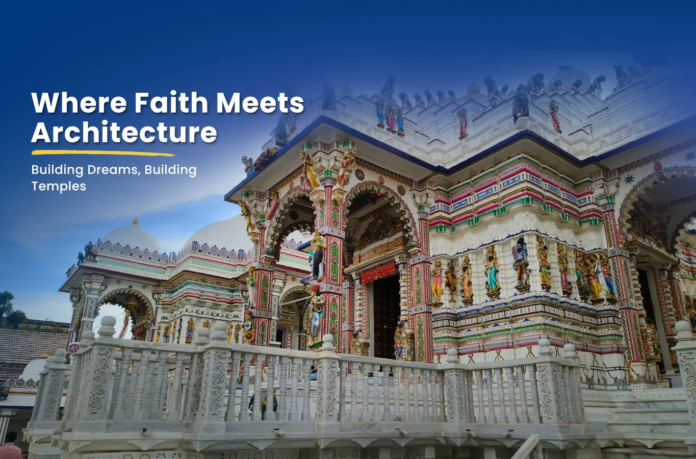Building a temple is a sacred and intricate process that combines spirituality, architectural expertise, and meticulous planning. Each step of temple construction reflects cultural traditions and religious significance. This article outlines the comprehensive steps involved in Temple Construction Services, emphasizing the role of Temple Architects in India, the contributions of the Jain Temple Sompura artisans, and the excellence of Temple Construction Services in Gujarat.
Step 1: Conceptualization and Planning
Understanding Religious and Cultural Requirements
The process begins with understanding the spiritual and cultural needs of the community. Whether it is a Hindu temple or a Jain temple, the design reflects the philosophy and beliefs of the respective religion. Discussions with spiritual leaders, local stakeholders, and architectural experts guide the conceptualization phase.
Role of Temple Architect in India
Temple Architect in India play a pivotal role during this phase. They ensure that the design aligns with traditional architectural principles, such as Vastu Shastra, while considering the site’s geographical and environmental conditions.
Step 2: Site Selection and Orientation
Choosing the Right Location
The site for a temple is carefully selected based on religious guidelines and environmental factors. For instance, Jain temples are often located on hills or near rivers to signify purity and spiritual elevation.
Orientation and Alignment
The orientation of the temple is crucial. Most temples are designed to face the east to welcome the morning sun, symbolizing enlightenment and divine energy.
Step 3: Architectural Design and Blueprint
Creating the Mandala-Based Layout
The blueprint of a temple is often based on a mandala, a sacred geometric pattern. This ensures that the structure is symmetrical, harmonious, and spiritually uplifting. The garbhagriha (sanctum sanctorum), where the deity resides, is placed at the center of the design.
Contributions of Jain Temple Sompura Architects
The Jain Temple Sompura architects are known for their expertise in designing temples with intricate layouts and carvings. Their blueprints are detailed, capturing both spiritual significance and architectural precision.
Step 4: Material Selection and Procurement
Traditional Materials for Temple Construction
Temples are constructed using high-quality natural materials such as:
- Marble: Commonly used in Jain temples for its purity and elegance.
- Granite and Sandstone: Preferred for their durability and aesthetic appeal.
Role of Gujarat in Material Supply
Gujarat plays a vital role in temple construction by providing premium materials like marble and sandstone. The state’s proximity to stone quarries ensures timely procurement of materials, making it a hub for Temple Construction Services in Gujarat.
Step 5: Foundation and Structural Construction
Rituals Before Construction
Before construction begins, rituals such as Bhoomi Pooja (worship of the land) are performed to seek blessings for the project.
Building the Foundation
The foundation of the temple is laid with precision, ensuring stability and longevity. Advanced techniques are often combined with traditional methods to strengthen the structure.
Step 6: Crafting and Carving
Sculpting Intricate Details
One of the most time-intensive stages, crafting and carving, involves creating detailed sculptures, ornate pillars, and intricate ceilings. Jain temples, in particular, are known for their elaborate carvings, such as those seen in the Ranakpur Jain Temple and Dilwara Temples.
Expertise of Jain Temple Sompura Artisans
The Sompura community, renowned for its temple craftsmanship, brings these designs to life with unparalleled skill. Their work blends traditional artistry with innovative techniques, ensuring that each detail aligns with Jain principles of spirituality and simplicity.
Step 7: Construction of the Superstructure
Building Towers and Domes
The superstructure, including the shikhara (tower) and mandapa (assembly hall), is constructed with precision. These elements symbolize the temple’s connection to the heavens.
Integration of Modern Techniques
While traditional methods remain central, modern tools and technologies are used to enhance the speed and accuracy of construction. This is especially true for Temple Construction Services in Gujarat, which seamlessly combine tradition with innovation.
Step 8: Installation of the Deity
Pran Pratishtha Ceremony
Once the temple structure is complete, the idol of the deity is installed in the garbhagriha. This process, known as Pran Pratishtha, involves elaborate rituals to infuse the idol with divine energy.
Significance in Jain Temples
In Jain temples, the idols of Tirthankaras are carefully crafted and installed in a serene and sanctified environment, emphasizing peace and detachment.
Step 9: Finishing Touches and Decoration
Adding Aesthetic Elements
The final stage involves polishing the carvings, painting decorative elements, and adding features like ornamental gates and lighting. The temple’s beauty is enhanced to create an inviting and inspiring space for devotees.
Sustainable Practices in Temple Construction
Modern temples increasingly adopt eco-friendly practices, such as using solar power and rainwater harvesting, aligning with Jainism’s emphasis on environmental harmony.
Step 10: Inauguration and Maintenance
Temple Inauguration Ceremony
The construction concludes with an inauguration ceremony, often marked by grand festivities and rituals. The temple is then opened to the public for worship.
Long-Term Maintenance
Preserving the temple’s beauty and structural integrity is crucial. Regular maintenance, including cleaning, repairing, and restoring carvings, ensures the temple remains a spiritual and architectural marvel for generations.
The Excellence of Temple Construction Services in Gujarat
Gujarat has established itself as a leader in temple construction, thanks to its rich tradition of skilled artisans and abundant natural resources. From designing intricate Jain temples to restoring historic sites, Temple Construction Services in Gujarat play a vital role in upholding India’s architectural heritage.
Conclusion
The construction of a temple is more than a physical process; it is a spiritual journey that brings together devotion, tradition, and architectural brilliance. Guided by the expertise of Temple Architects in India and the craftsmanship of the Jain Temple Sompura community, temples are created to inspire awe and reverence.
With the support of Temple Construction Service in Gujarat , this sacred art continues to thrive, blending ancient traditions with modern innovations. From design to completion, every step of temple construction reflects a deep commitment to preserving India’s cultural and spiritual legacy.



